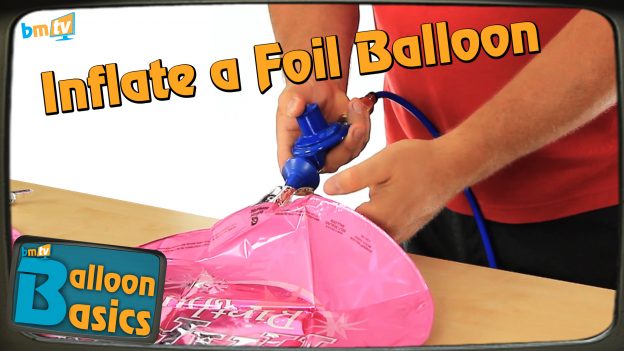In this week’s Balloon Basics show, we learn how to inflate an 18-inch foil balloon and the benefits of using the correct inflator nozzle.
The correct inflator for a foil balloon is the auto fill cut-off valve. We sell these both in the “quick-connect” variety that attaches to the extension hose and the version that attaches directly to the cylinder that comes with a gauge and a latex inflator. The beauty of this inflator is that it automatically cuts off the supply of helium when the foil balloon is inflated to the correct size. This is perfect for not only avoiding bursting balloons but also increases the float time of the balloon because it is a low-pressure inflator. We’ll explain more about this later!
First off though, insert the tapered tip of the inflator into the neck of the foil balloon and hold the neck of the balloon with your fingers to create a tight seal. Pull back on the inflator and the balloon will be inflated steadily. Wait for the inflator to cut off by itself and all you need to do is remove it from the balloon! A foil balloon that has a self-sealing valve will prevent any helium from escaping but if you are working with foil balloons that don’t have valves; you will need to heat seal them. Check out our video on how to do this. Another benefit of using the auto cut-off is that it will leave some creases in the balloon that will allow for the gas to expand in hot conditions, again avoid the chance the balloon could burst.
Now the reason why you need to use a low-pressure inflator for foil balloons is that when you inflate a foil balloon, the gas passes through a plastic valve. If you used a high-pressure latex inflator on a foil balloon, the high pressure would cause the plastic in the valve to stretch. This means that it doesn’t close properly and Helium will start to escape the balloon sooner. Mark was telling us that in their tests, a foil balloon that has been inflated using a high-pressure inflator will actually float for 25% less time that one inflated with a low-pressure inflator. High pressure inflators include the Tilt Valve, Push Valve and Trigger outlet.
That’s it for this week, see you next time!
Rob
As always, you can get in touch with us by commenting below, sending us an email or commenting on Facebook and Twitter. If you would like to receive these weekly video updates, you can either keeping checking this blog, subscribe to email updates in your account settings or you can subscribe to our Youtube channel.








